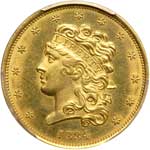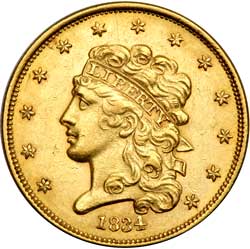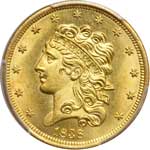
|
Sale 78
January Pre-Long Beach Sale 17.5% BP
| Lot |
Photo |
Description |
Realized |
Lot 1783 |
 |
1834. Plain 4. PCGS graded MS-63. Lovely golden toning reflective surfaces. A solid MS63 in all regards. The lustrous surfaces are alight with sizzling golden luster, the strike is clear-cut with the only diminution being some hair curls at Liberty�s temple, and the eye appeal is nothing short of exceptional. All stars are bold; the eagle displays full, radiant and glowing plumage including the (often weak) neck feathers. First year of William Kneass�s new style.
Congress passed the Mint Act of June 28, 1834, reducing the weight of all gold coins. As soon as it became apparent that this bill had a good chance of passage, the 24,568 half eagles of the old tenor standard With Motto held in the Mint since manufacture, May 30, went back to the Melter and Refiner. Anticipating floods of old-tenor (1795-1834 heavier-standard) gold for recoinage, Mint Director Samuel Moore ordered Engraver William Kneass to prepare new dies in quantity. Instead of following the original congressional recommendation to distinguish the new dies by adding AUGUST 1, 1834 to the date, Moore ordered Kneass to redesign them omitting the Great Seal's motto, E PLURIBUS UNUM.
The anticipated flood of older coins did materialize, explains the Breen Encyclopedia, "it has been estimated that over 99% of the original pre-1834 mintage was melted, 1834-43, much of it being turned into Classic Head half eagles." Pop 40; 43 finer, 38 in 64, 2 in 64+, 2 in 65, 1 in 66. (PCGS # 8171) .
Estimated Value $8,000 - 9,000.
View details and enlarged photos
Check results on similar lots
| Realized
$15,863 |
Lot 1784 |
 |
1834. Plain 4. PCGS graded MS-63. Nice semi prooflike surfaces. An elevated degree of blistering luster springs to life beneath rich gold highlights surrounded by the aforementioned reflective quality in the fields. Somewhat yielding at the obverse where Liberty�s lovelock curl is modestly flat, though much more detail can be found on the other hair detail than on the typical example of the date. A respectable Choice MS63 that will be a centerpiece in someone�s early gold Type Set.
Coinages of the new 1834 No Motto design far exceeded even the Mint's most optimistic expectations. The coins went at once into circulation and stayed there, few being saved as souvenirs. As a result, Uncirculated survivors are very rare, though Fine to Extremely Fine specimens are plentiful. They are mementos of a period of rapid change, growth, and experimentation at the Philadelphia Mint, immediately succeeded by decades of what Breen in his Encyclopedia describes as "stereotypy" (meaning the succeeding Coronet Design). Pop 40; 43 finer, 38 in 64, 2 in 64+, 2 in 65, 1 in 66. (PCGS # 8171) .
Estimated Value $8,000 - 9,000.
View details and enlarged photos
Check results on similar lots
| Unsold |
Lot 1785 |
 |
1834. Plain 4. PCGS graded MS-61. CAC Approved. Well struck and delicately toned, the luster is even and muted. Few examples of the 1834 Capped Head half eagle survive today, and seldom are they found in Mint State grades (PCGS # 8171) .
Note: In summer 1834, the $5 denomination was redesigned by William Kneass, who created what is now known today as the Classic Head style.
The new 1834 issue is similar in design to the quarter eagle of the same date. The obverse depicts the head of Liberty facing left, her hair secured by a band inscribed LIBERTY, with stars circling her head, and the date below.
The reverse shows an eagle with a shield on its breast, grasping an olive branch and holding three arrows. The inscription UNITED STATES OF AMERICA, 5 D. surrounds. The motto E PLURIBUS UNUM, used earlier, was discontinued.
The authorized standard was reduced from 135 grains to 129 grains via the Act of June 28, 1834. This was put into effect on August 2, 1834, and coins struck on and after that date were of the new weight. The strategy to encourage circulation of gold coins within United States borders proved successful; it was no longer profitable to melt or export coins for bullion, and gold coins circulated at par for the first time since the War of 1812.
Estimated Value $3,000 - 3,500.
The Del Valle Collection.
View details and enlarged photos
Check results on similar lots
| Realized
$5,288 |
Lot 1786 |
 |
1836. PCGS graded MS-62. Nice light golden toning. Glinting deep-frosted luster graces satiny and dynamic golden surfaces. What also sparks our interest is the varying shades of light gold that mingle broadly with bold gold iridescence. Struck with almost scientific precision on the key areas such as the stars, all of Liberty�s hair waves and curls, and throughout the eagle. A few light marks and hairlines, in line with MS63 quality. An attractive coin that shows off its bold strike proudly. Pop 37; 29 finer, 11 in 63, 16 in 64, 2 in 65. (PCGS # 8174) .
Estimated Value $5,000 - 5,500.
View details and enlarged photos
Check results on similar lots
| Realized
$7,050 |
Lot 1787 |
 |
1838. PCGS graded MS-63+. CAC Approved. PQ. A nice well struck frosty gold coin. Looks like a MS-64 coin. A gorgeous specimen of the optimum, hand-picked quality. The extremely lustrous surfaces show signs of mingled two-tone contrast between the more smooth fields and satin-like frost on the devices. Agreeably well struck to say the least, and in fact, fully so, detail enough to merit special reference here. Full stars and hair; full eagle plumage. Some minor contact in the reverse field.
From 1834 through 1838 large quantities were produced, with bullion supplied from gold production in North Carolina and Georgia and by gold shipments received from France as an indemnity for spoliation against American commerce during the Napoleonic Wars. Though the major source for bullion was melted "old-tenor" pieces of the previous With Motto style. Much of the mintage was accomplished at Philadelphia. In 1838, the branch mints at Charlotte and Dahlonega produced coins for the first time. Such mintmarked pieces are rare today. Pop 1; 23 finer, 19 in 64, 3 in 65, 1 in 66. (PCGS # 8176) .
Die Note: Just two die varieties are known for the 286,538 coins struck. McCloskey-1A. Perfect dies. Fancy 8, double forehead curl. With berry in branch, no tongue, arrow feather over center of 5. Small 5, large arrowheads.
Estimated Value $9,000 - 10,000.
View details and enlarged photos
Check results on similar lots
| Realized
$24,675 |
|
|